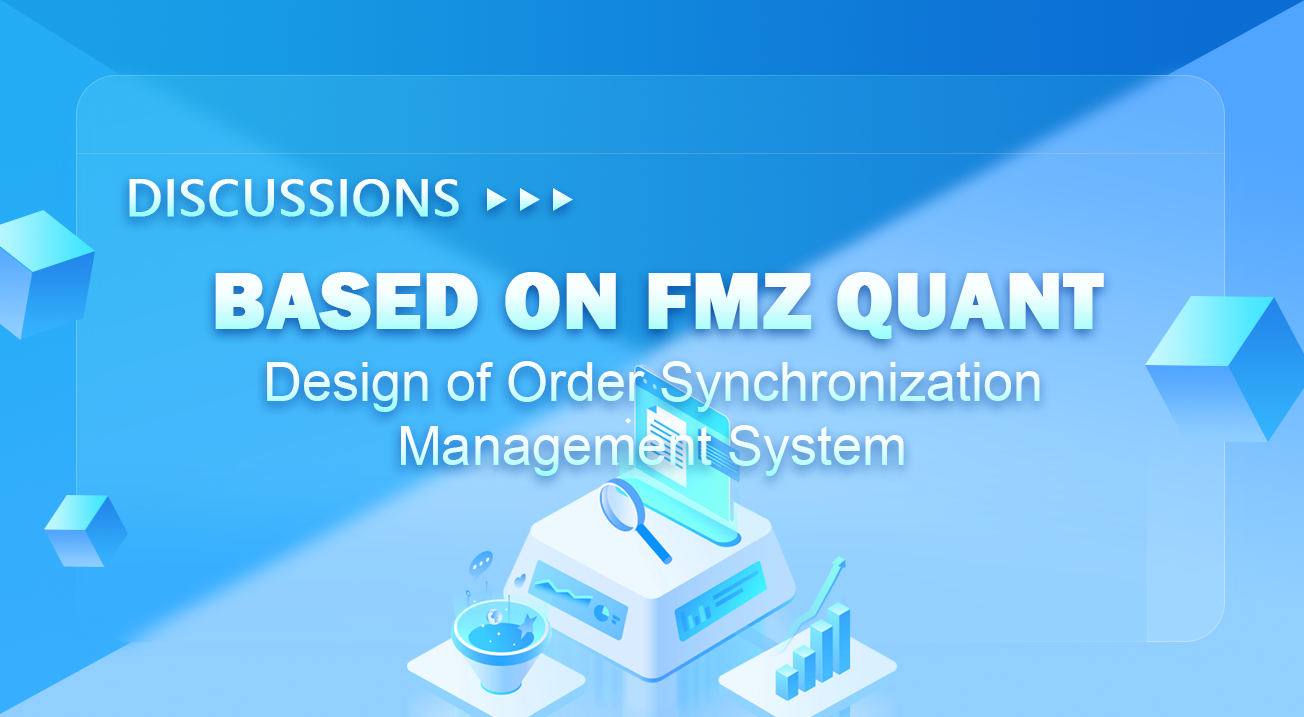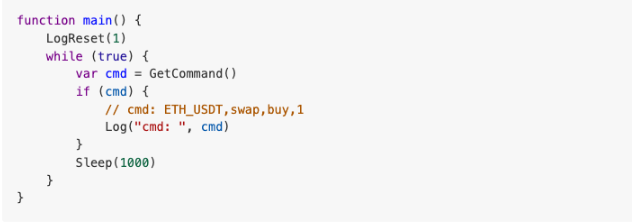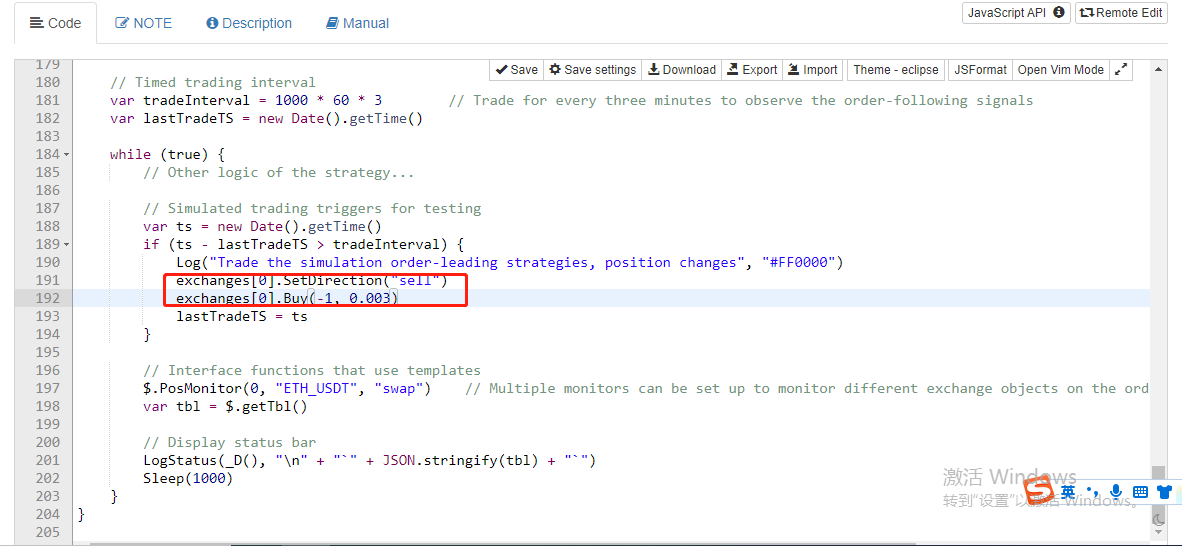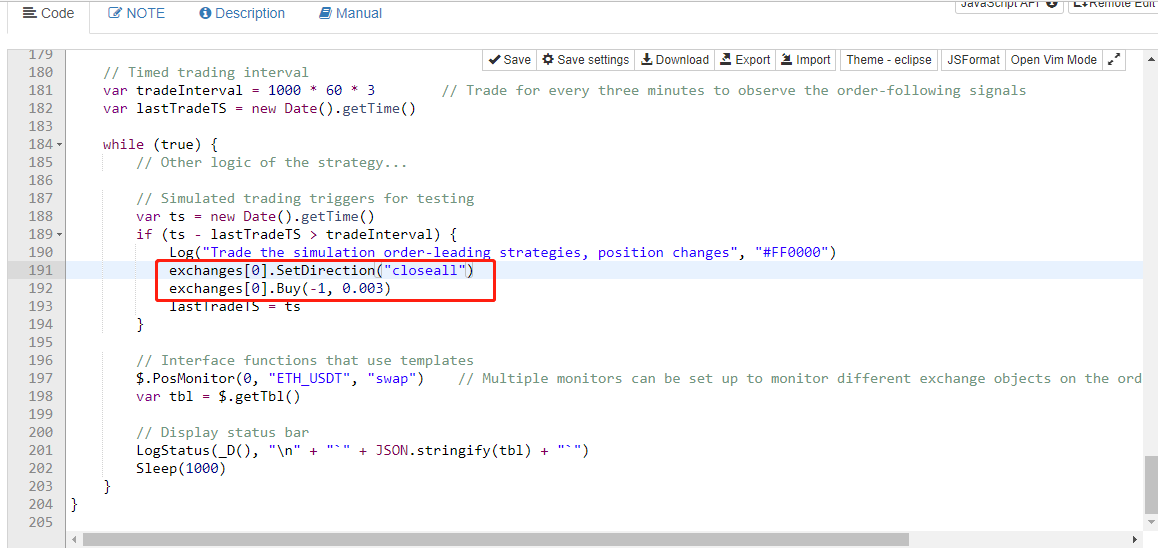Projeto de Sistema de Gestão da Sincronização de Encomendas Baseado no FMZ Quant (2)
Autora:FMZ~Lydia, Criado: 2022-11-08 11:34:20, Atualizado: 2023-09-15 20:48:46
Projeto de Sistema de Gestão da Sincronização de Encomendas Baseado no FMZ Quant (2)
Sistema de Gestão de Sincronização de Encomendas (Servidor Sincrônico)
Continuemos com a discussão do artigo anterior: Projeto do Sistema de Gestão de Sincronização de Encomendas Baseado na Quantificação FMZ (1) (https://www.fmz.com/digest-topic/9729) e começar a conceber uma estratégia de acompanhamento sincronizado das ordens.
Pense em algumas dessas questões de design:
-
- Se você não quiser executar o seguimento de ordem sincronizado temporariamente, é possível pausa-lo? Uma vez suspenso, é proibido iniciar a partir da API estendida, deve ser autenticado pela senha. Implementar esta função adicionando 2 variáveis globais:
var isStopFollow = false // Used to mark whether the current order is being followed
var reStartPwd = null // Used to record the restart password

Em seguida, adicionamos controles interativos na página de edição de estratégia para pausa estratégia / reiniciar (não para parar o bot real, apenas pausa lógica, não mais ordem de seguimento).Order Synchronization Management System Class Library (Single Server)Quando reiniciar a função de seguir ordens, digite a senha pré-definida para acordar a função de seguir ordens.
Código para a execução das funções relevantes:
...
// Judge the interaction command
if (arr.length == 2) {
// Buttons with controls
if (arr[0] == "stop/restart") {
// Pause/restart order-following
if (!isStopFollow) {
isStopFollow = true
reStartPwd = arr[1]
Log("it has stopped the order-following,", "Set the restart password as:", reStartPwd, "#FF0000")
} else if (isStopFollow && arr[1] == reStartPwd) {
isStopFollow = false
reStartPwd = null
Log("it has restarted the order-following, ", "Clear the restart password.", "#FF0000")
} else if (isStopFollow && arr[1] != reStartPwd) {
Log("Restart password error!")
}
}
continue
}
-
- Você pode especificar a quantidade de ordens a serem seguidas ou pode ser dimensionado em múltiplos Adicionar parâmetros à estratégia:

specifiedAmount: especificar o número de ordens seguidas, o valor por defeito é -1, ou seja, não especificado. zoomAmountRatio: Escalagem de acordo com a quantidade de ordens enviadas, por exemplo, se o sinal enviado for: ETH_USDT,swap,buy,1, multiplicar o valor do valor do montante de ordens por zoomAmountRatio. O padrão é -1, ou seja, sem escalagem.
var amount = specifiedAmount == -1 ? action.amount : specifiedAmount
amount = zoomAmountRatio == -1 ? amount : amount * zoomAmountRatio
Aqui, é implementado para escalar ou especificar um valor específico para o número de ordens a serem seguidas no sinal recebido.
-
- O código deve ser o mais simples possível, utilizar outras bibliotecas de modelos para fazer uma encomenda.
A biblioteca de classes utilizada pelas ordens spot colocada:https://www.fmz.com/strategy/10989A biblioteca de classes utilizada por pedidos futuros colocados:https://www.fmz.com/strategy/203258
function trade(action) {
// Switch trading pairs and set up contracts
exchange.SetCurrency(action.symbol)
if (action.ct != "spot") {
exchange.SetContractType(action.ct)
}
var retTrade = null
var amount = specifiedAmount == -1 ? action.amount : specifiedAmount
amount = zoomAmountRatio == -1 ? amount : amount * zoomAmountRatio
if (action.direction == "buy") {
retTrade = action.ct == "spot" ? $.Buy(amount) : $.OpenLong(exchange, action.ct, amount)
} else if (action.direction == "sell") {
retTrade = action.ct == "spot" ? $.Sell(amount) : $.OpenShort(exchange, action.ct, amount)
} else if (action.direction == "closebuy") {
retTrade = action.ct == "spot" ? $.Sell(amount) : $.CoverLong(exchange, action.ct, amount)
} else if (action.direction == "closesell") {
retTrade = action.ct == "spot" ? $.Buy(amount) : $.CoverShort(exchange, action.ct, amount)
}
return retTrade
}
Então podemos ver que fazer uma ordem só precisa de uma frase:$.Sell(amount), $.Buy(amount), $.OpenLong(exchange, action.ct, amount). etc.
Código de estratégia:
O código temporário do anteriorOrder Synchronous Management System (Synchronous Server)foi o seguinte:

Agora começamos a redesenhar o Sistema de Gerenciamento de Sincronização de Encomendas (Servidor Sincrônico):
// Global variables
var isStopFollow = false
var reStartPwd = null
function trade(action) {
// Switch trading pairs and set up contracts
exchange.SetCurrency(action.symbol)
if (action.ct != "spot") {
exchange.SetContractType(action.ct)
}
var retTrade = null
var amount = specifiedAmount == -1 ? action.amount : specifiedAmount
amount = zoomAmountRatio == -1 ? amount : amount * zoomAmountRatio
if (action.direction == "buy") {
retTrade = action.ct == "spot" ? $.Buy(amount) : $.OpenLong(exchange, action.ct, amount)
} else if (action.direction == "sell") {
retTrade = action.ct == "spot" ? $.Sell(amount) : $.OpenShort(exchange, action.ct, amount)
} else if (action.direction == "closebuy") {
retTrade = action.ct == "spot" ? $.Sell(amount) : $.CoverLong(exchange, action.ct, amount)
} else if (action.direction == "closesell") {
retTrade = action.ct == "spot" ? $.Buy(amount) : $.CoverShort(exchange, action.ct, amount)
}
return retTrade
}
function parseCmd(cmd) {
var objAction = {}
// Parse cmd, such as: ETH_USDT,swap,buy,1
var arr = cmd.split(",")
if (arr.length != 4) {
return null
}
objAction.symbol = arr[0]
objAction.ct = arr[1]
objAction.direction = arr[2]
objAction.amount = arr[3]
return objAction
}
function main() {
// Clear all logs
LogReset(1)
if (isSimulateOKEX) {
exchange.IO("simulate", true)
Log("Switch to OKEX demo!")
}
// Set accuracy
exchange.SetPrecision(pricePrecision, amountPrecision)
// Check zoom and specify it cannot be set at the same time
if (specifiedAmount != -1 && zoomAmountRatio != -1) {
throw "it cannot specify simultaneous volume and scaling volume at the same time"
}
while (true) {
var cmd = GetCommand()
if (cmd) {
Log("cmd: ", cmd)
var arr = cmd.split(":")
// Judge interaction commands
if (arr.length == 2) {
// Buttons with controls
if (arr[0] == "stop/restart") {
// Pause/restart order-following
if (!isStopFollow) {
isStopFollow = true
reStartPwd = arr[1]
Log("it has stopped the order-following.", "Set the restart password as.", reStartPwd, "#FF0000")
} else if (isStopFollow && arr[1] == reStartPwd) {
isStopFollow = false
reStartPwd = null
Log("it has restarted the order-following", "Clear the restart password.", "#FF0000")
} else if (isStopFollow && arr[1] != reStartPwd) {
Log("Restart password error!")
}
}
continue
}
// Permission to follow orders
if (!isStopFollow) {
// Resolve the interaction instructions of order-following signal
var objAction = parseCmd(cmd)
if (objAction) {
// The analysis is correct
var ret = trade(objAction)
} else {
Log("Wrong signal command cmd:", cmd)
}
}
}
// Display order-following status
LogStatus(_D(), isStopFollow ? "Stop Synchronization" : "Keep Synchronization", "\n")
Sleep(1000)
}
}
Teste
Nós testamos a conta de liderança de ordens usando o Binance real bot para este tempo, e nós usamos a conta OKEX para ordem de seguimento real bot.mainFunção na função de ensaio(Order Synchronization Management System Class Library (Single Server)no modelo) utilizado no artigo anterior.

Aqui, mudamos a direção da transação para

Em seguida, vamos testar o fechamento da posição alterando a direção da ordem na função principal de teste para fechar a posição curta em 0,003.

Em seguida, executá-lo novamente, que é responsável pela ordem de liderança (Order Synchronization Management System Class Library (Single Server)).
A mesma operação foi desencadeada por um robô real que seguiu ordens.
O endereço da estratégia: Biblioteca de classes do sistema de gestão de sincronização de ordens (servidor único) (https://www.fmz.com/strategy/345171) Sistema de gestão de sincronização de encomendas (Servidor síncrono) (https://www.fmz.com/strategy/345172)
A estratégia é concebida apenas para comunicação e aprendizagem, por favor ajuste e otimize de acordo com as necessidades reais.
- Introdução à arbitragem de lead-lag em criptomoedas (2)
- Introdução ao suporte de Lead-Lag na moeda digital (2)
- Discussão sobre a recepção de sinais externos da plataforma FMZ: uma solução completa para receber sinais com serviço HTTP em estratégia
- Discussão da recepção de sinais externos da plataforma FMZ: estratégias para o sistema completo de recepção de sinais do serviço HTTP embutido
- Introdução à arbitragem de lead-lag em criptomoedas (1)
- Introdução ao suporte de Lead-Lag na moeda digital
- Discussão sobre a recepção de sinais externos da plataforma FMZ: API estendida VS estratégia Serviço HTTP integrado
- Exploração da recepção de sinais externos da plataforma FMZ: API de extensão vs estratégia de serviços HTTP embutidos
- Discussão sobre o método de teste de estratégia baseado no gerador de tickers aleatórios
- Métodos de teste de estratégias baseados em geradores de mercado aleatórios
- Novo recurso do FMZ Quant: Use a função _Serve para criar serviços HTTP facilmente
- Explicação pormenorizada dos algoritmos de duplicação de retroceder de futuros
- Ganha 80 vezes em 5 dias, o poder da estratégia de alta frequência
- Pesquisa e exemplo sobre a concepção da estratégia de cobertura de Maker Spots e Futures
- Construção de um banco de dados quantitativo de FMZ com SQLite
- Como atribuir dados de versões diferentes a uma estratégia alugada por meio de metadados de código de aluguel de estratégia
- Arbitragem de juros da Binance Perpetual Funding Rate (Current Bull Market Annualised 100%)
- Estratégia de ponto de virada de futuros de moeda digital com dupla EMA (Tutorial)
- Subscrever Nova Estratégia de Ações para Spot de Moeda Digital (Tutorial)
- Realizar uma ideia com 60 linhas de código - Estratégia de pesca no fundo do contrato
- O valor da moeda digital é o valor de todas as moedas em que a moeda é utilizada.
- Estratégia ATR multiespécies de futuros de moeda digital (tutorial)
- Escrever uma ferramenta de negociação semi-automática usando a linguagem Pine
- Explore o Design de Estratégia de Alta Frequência da Mudança Mágica do LeeksReaper
- Análise da estratégia do LeeksReaper (2)
- A "Magic Double EMA Strategy" dos Veteranos do YouTube
- Implementação da linguagem JavaScript dos indicadores de Fisher e desenho no FMZ
- Exemplo de projeto de estratégia dYdX
- Projeto de Sistema de Gestão da Sincronização de Encomendas Baseado no FMZ Quant (1)
- Análise da estratégia do LeeksReaper (1)
- O montante das posições em risco da derivada deve ser calculado de acordo com o método de classificação da derivada.